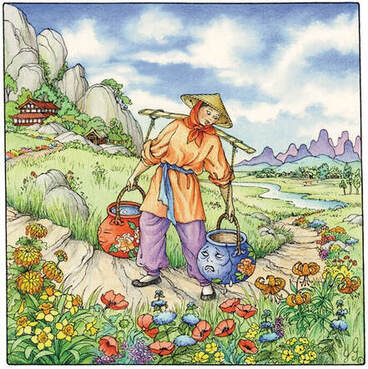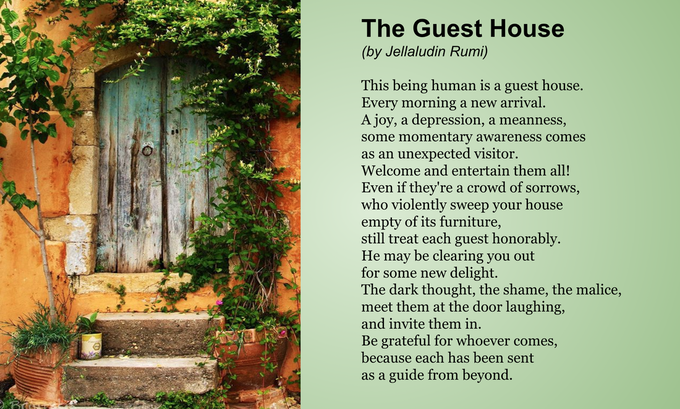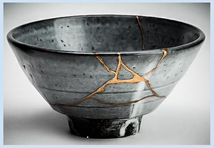|
As we enter deep into the spirit of Christmas and into the darkness of winter, we celebrate how hope and new life emerged out of peasant town called Bethlehem during one of the most violent times of Roman rule in Israel. New life comes out of unexpected places, sometimes in spaces might perceive as insignificant and not worthy of attention.  The Parable of the Broken Jar Once upon a time, there were two water jars used by a peasant to draw water from a well to his house. One jar was perfectly new, while the other one was old and cracked. The jars hung on opposite sides of a pole that the owner put over his shoulders. The old jar was feeling depressed and sorry for itself for being old, worn and having a crack. So one day, it spoke to the owner: "I'm sorry for all of your hard work you are doing each day to bring water to your family. However, I continue to be unhelpful and useless. Because of my crack, I spill the water that you carry from the well to your house." The owner replies: "Tomorrow when we get water from the well and walk back to the house, I want you to look at your side of the path, and notice what you see." So on the way back from the well, the old jar did the usual spilling of its water on the path. But the owner reminded him: "See on your side of the path? It is filled with beautiful flowers. I always knew about your crack, so I threw flower seeds on your side. And because of the water that you've spilled, the seeds have grown into flowering plants. I have picked these flowers, placed them in a vase in our house for my family to enjoy. So if it were not for your crack, how could my family have benefited from the flowers that you have provided all these months?"  Perfectionism & Busy-ness Brene Brown says that riding through life driven by perfectionism is not a fun ride: "When perfectionism is driving us, shame is riding shotgun and fear is that annoying backseat driver." Perfectionism conditions us to be ashamed of our cracks. We learn to ignore them not by slowing down, but by speeding up through our busy lives. While slowing down to rest might be what is needed, the act of slowing down can can threaten the mask of perfectionism. Slowing down unveils it. In my work in bereavement, many of bereaved individuals will automatically default to busying themselves as a form of distraction from confronting feelings that accompany the loss of their loved ones. Running away from feelings of grief works only for a while. A grieving daughter told me, “For a while for many months I was OK. I went back to work, back to my regular routine. Then for some reason, my grief came out of nowhere. I was in a baseball game with my husband, everyone was cheering, happy and celebrating. And there, in the middle of the party, I was overcome with an explosion of grief and sobs over the death of my dad.” Just because the emotional injury caused by life's crisis is not outwardly visible, we assume it is in a totally different category from physical injury and that we can simply ignore our grief and go back to "normal" - the way it used to be. Ignoring one's grief may be likened to someone throwing away a boomerang, hoping that it will never come back, but then grief whacks us in the back of our heads when we least expect it. Slowing Down & Going Home If we find auto-piloting in our usual routines after a surgery ill-advised, so it is with emotional injuries. Healing is never about speeding our way back to our regular routines. A good healer will tell us to slow down so our bodies recuperate. Such person will tell us to pay attention to avoid reinjury. When we are injured by the violent tremors of significant life transitions (grief caused by death, health change, mid-life crisis, divorce, economic instability), the best way to heal is to slow down. Thich Nhat Hanh says it well:  Facing uncomfortable feelings (sadness, despair, anger, fear, anxiety) can be very intimidating especially in a culture that recognizes such feelings are impractical and a waste of time. However, the mystic poet Jellaludin Rumi invites us to meet our feelings head on. To him, this skillset of befriending our emotions as sort of like being a host to a guest that has come to knock on our doors. We need to welcome them and let them in.  The skillset that Jellaludin Rumi invites us to embody is easier said than done especially in a culture that considers the expression of feelings as a sign of weakness. Often I encounter many bereaved clients who find their feelings of grief shameful. This is especially true for men who are conditioned to keep their feelings hidden to present a fake persona of resilience.  Shame Researcher on resilience, Brene Brown, talks about shame as a shackle that keeps us from claiming our power. She explains that if you put shame in a petri dish, it needs three ingredients to grow exponentially: secrecy, silence and judgement. In JK Rowling's Harry Potter, the Dark Lord is powerful by the fact that he is the one who must not be named. Shame's default is to sweep difficult thoughts and bad feelings under the rug. Keeping things unnamed and invisible is how shame keeps its powerful grip on us, paralyzing us from claiming that we are strong enough make changes we need to make. But no matter how much we keep shame out of our awareness, it always comes back to return and haunt us. Christian tradition has an antidote to shame: confession (or penance). When the dark and shameful parts of ourselves are being witnessed without judgment by an empathetic listener, shame's powerful grip loses strength. Fully accepted and held in love, the parts of ourselves that are cracked and jagged gets to be seen in a different light. We are perfect in our imperfection and begin to hear the truth when God says: "You are my beloved child with whom I am well pleased" (Mark 1:11). New Life  With this affirmation, new life happens. But new life is not comfortably fuzzy, cute, spiffy, clean-cut, frangrant or crystal clear. New can be messy and at times confusing. New life comes from out of the stench of the dark tomb. New life emerges out of the dirt. Decaying compost and mulch nourishes the seeds and the growing plant in the spring.  In the end of the Story of the Cracked Pot, the cracked pot was eventually able to claim the beauty of its imperfection. In the art of Japanese pottery called Kintsugi, broken bowles are repaired with gold. The flaw is seen as a unique piece of the object's history, which adds to its beauty. Thus kintsugi is the art of precious scars. As we live with our prescious scars and inner cracks, may we find hope in our journeys. May we have the eyes to see the emerging of new life and beginnings in the dark crevices of our human experience.
12/14/2021 11:38:36 pm
Excellent article! Your post is essential today. Thanks for sharing, by the way. Comments are closed.
|
Donnel Miller-MutiaJoin me in chewing the cud on mindful communication and relationships, self-awareness, spirituality and mythology. Archives
May 2024
Categories |
Proudly powered by Weebly

 RSS Feed
RSS Feed
